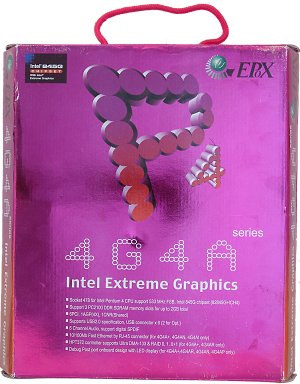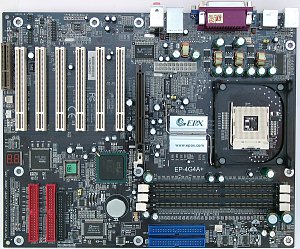EPoX 4G4A+ (i845G) Mainboard
|

The designers work well - this time we have a new design of the box
which, most likely, will be used for this series only.
Accessories:
-
Package of an interesting design with a handle which doesn't look like
ordinary blue boxes or plastic packages;
-
Documentation: user manual, guide for IDE RAID - in English;
brief installation guide in 6 languages;
-
Cables: 1 ATA66/100/133 and FDD;
-
Bracket with a serial port and a Game port;
-
Bracket for the rear computer panel;
-
Diskette with drivers for IDE RAID;
-
2 CDs containing:
-
drivers;
-
Boostek;
-
several system monitoring utilities;
-
Adobe Acrobat Reader;
-
Norton Ghost 7.0;
-
PC-Cillin 2000;
-
Power Quest Drive Image 4.0;
-
Power Quest Partition Magic SE 6.0;
-
DirectX 7.0a.

The layout is not very good: audio-ins are in bad positions, as well
as USB, Game port, SPDIF, IDE RAID and power connectors, and when a video
card is installed it's difficult to handle memory modules - but this is
the cost of high functionality. However, it's not difficult to reach some
jumpers when the board is already installed. Their functions are shown
on the textolite.
The 3-channel switching voltage regulator incorporates 10 capacitors
of 3300 uF.
The following controllers are integrated:
-
audio controller based on the Avance Logic ALC650 codec supporting 5.1
audio systems and having an SPDIF connector;
-
network controller based on the Realtek RTL8100B chip and supporting 10BaseT/100BaseTX;
-
IDE RAID based on the HighPoint HPT372 chip supporting RAID 0, 1, 0+1 using
the ATA133 protocol.
The board sports a POST controller based on two 7-segments LEDs informating
about problems during booting.
Non-unsoldered connectors: none.
The system monitoring is supported by the Winbond W83627HF-AW chip.
What is controlled:
-
voltage of processor, AGP bus, memory, +/-5 and +/-12 V, VBAT and +5 V
Standby;
-
speed of 3 fans;
-
temperatures of the processor (a built-in sensor) and the board (a built-in
sensor).
There are 2 connectors for adjustable and 1 for unadjustable connection
of fans.
Brief characteristics of the board: memory slots - 3 DDR SDRAM;
expansion slots - AGP/ 6 PCI /CNR; I/O ports - 2 COM/ LPT/ 2 PS/2/ 6 USB
2.0; dimensions - 305x245 mm.

Adjustment can be carried out with:
| jumpers and switches |
Jumper to clear up the CMOS |
|
| Jumpers to choose a FSB frequency |
Default, 100 and 133 MHz |
| Jumper for starting up computer from PS/2 keyboard |
|
| BIOS based on the 6.00PG version from Award |
Setup of memory timings |
+ |
CAS Latency, Active To Precharge Delay, RAS to CAS Delay, RAS
Precharge |
| Setup of memory frequency |
+ |
Auto, DDR200, DDR266, DDR333 |
| Setup of AGP bus |
+ |
|
| Setup of PCI bus |
- |
|
| Changeable scaler of AGP and PCI buses |
+ |
Auto, PCI (AGP/2) = 33 MHz, FSB/3 |
| Manual assignment of interrupts |
+ |
|
| Changeable FSB frequency |
+ |
90-200 MHz in 1MHz steps |
| Changeable CPU multiplier |
+ |
x8-x50 |
| Changeable core voltage |
+ |
from -0.1 V to +0.35 V in 0.025V steps |
| Changeable memory voltage |
+ |
+0.1 V, +0.2 V, +0.3 V, +0.4 V, +0.5 V, +0.6 V, +0.7 V |
| Changeable chipset voltage |
- |
|
| Changeable AGP bus voltage |
+ |
+0.1 V, +0.2 V, +0.3 V, +0.4 V |
We used the latest available version of the BIOS of 17/06/02.
This is an interesting board; quality, functionality and a relatively low price
make this mode a good choice for almost any use.
|
|



